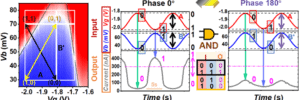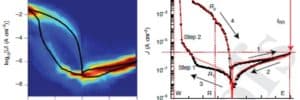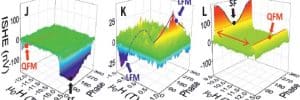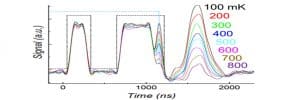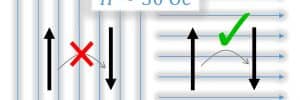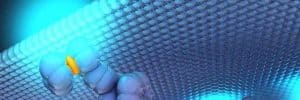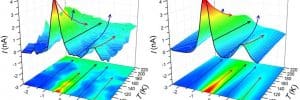We report in Advanced Materials a Single-Electron Logic Calculator (SELC) based on a single-molecule tunnel junction. It takes advantage of the unique electronic structure of two adjacent molecular orbitals of a Ferrocene molecule and their orthogonal control via bias and gate voltages.
Electric-field-driven dual-functional molecular switches in tunnel junctions
we report in Nature Materials a molecular tunnel junction based on molecules that provide an unprecedented dual functionality of diode and variable resistor, resulting in a molecular-scale 1D–1R RRAM with a current rectification ratio of 2.5 × 10^4 and resistive on/off ratio of 6.7 × 10^3, and a low drive voltage of 0.89 V
Subterahertz spin pumping from an insulating antiferromagnet
(Published in Science) We are successfully overcoming that natural resistance using electrical currents passed through anti-ferromagnets on the nanoscale. The results are groundbreaking because they represent proof of concept showing that antiferromagnetic devices can operate on the terahertz level — or calculations completed in a trillionth of a second.
Time-resolved electron paramagnetic resonance spectroscopy at 50mK
A time-resolved electron paramagnetic resonance spectrometry setup designed to work at frequencies below 20 GHz and temperatures down to 50 mK. The setup consists of an on-chip microstrip resonator (Q < 100) placed in a dilution cryostat located within a superconducting 3D vector magnet.
A “high”temperature single-ion magnet
A single-ion quantum magnet with characteristics surpassing all previous quantum magnets reported to date (published in PRL 2018). Del Barco’s group and collaborators in Germany have reported an outstanding analogy between the magnetism of “single Fe-atoms” embedded in solid state matrix (Li3N) and conventional molecular magnets.
Exploring the Marcus Regimes in a Molecular Double Quantum Dot
An international research team, which includes University of Central Florida Professor Enrique del Barco and Christian A. Nijhuis of the National University of Singapore, has found a way to understand and manipulate the transition of charges in molecular junctions. The results have been published in Nature Nanotechnology.
Record Rectification Ratio in a Molecular Diode
Del Barco and collaborators at University of Limerick (Ireland) and the National University of Singapore have cracked an important limitation that for nearly 20 years has prevented the practical use of molecular diodes. The results have been published and highlighted in the News & Views of Nature Nanotechnology.
PhYSICOS Summer Camp
The Department of Physics at UCF and the Graduate Society of Physics Students (GSPS), with the support of the Outreach Program of the GMAG group at the American Physical Society, present “Physics Youth Scholastic and Instructing Camp for Orlando Scientists” (PhYSICOS), a no-cost summer camp for high school students in the Orlando metropolitan area.
Electrostatic Control over Temperature-Dependent Tunneling across a Single Molecule Junction
We have reported a detailed charge transport study of an individual redox-active molecule (based on ferrocene) over a wide range of temperatures and applied potentials. The results show the temperature dependence of the current to vary strongly as a function of the gate voltage.
